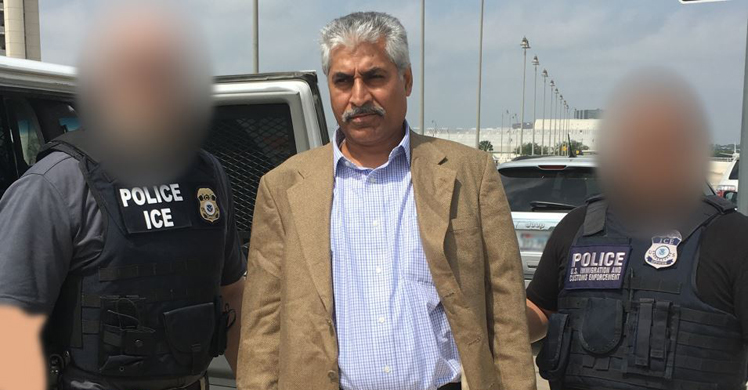ICE removes Pakistani who conspired to launder proceeds of terrorist financing
WASHINGTON – A Pakistani national and former D.C. business owner who served the last eight years in federal prison for conspiring to launder money and to concealing terrorist financing was turned over to authorities in Islamabad Wednesday by officers with U.S. Immigration and Customs Enforcement’s (ICE) Enforcement and Removal Operations (ERO).
Saifullah Anjum Ranjha, 53, pleaded guilty in 2008 to laundering more than $2.2 million – which he believed to be the proceeds of illegal activities conducted by al-Qaida, including drug trafficking and weapons smuggling. The investigation, which ultimately led to 42 arrests between 2008 and 2011, was led by ICE’s Homeland Security Investigations (HSI) Baltimore, the FBI and the Internal Revenue Service’s Criminal Investigation.
Ranjha, who owned homes in the District and Maryland and who had been living in the United States as a lawful permanent resident since 1997, used his money remitter business, Hamza Inc., to launder the funds internationally through an informal money transfer system called a “hawala.”
Ranjha’s removal was carried out by ICE as a “high profile removal” – a special designation given to foreign fugitives, national security threats, human rights violators and other special interest removals.
Ranjha departed the United States Monday from San Antonio International Airport in Texas under escort by deportation officers from ERO San Antonio. Upon his arrival in Pakistan, he was turned over to authorities there at the Benazir Bhutto International Airport in Islamabad.
Last year, ICE removed 351 individuals classified as high profile removals – 274 were wanted for crimes committed overseas, often of a very serious or violent nature; 20 were classified as human rights violators; and 54 were considered national security threats.
Other recent national security threats removed by ICE include the March removal of an Iranian man who pleaded guilty to exporting sensitive helicopter components in violation of U.S. exports laws. Also, in February, the agency removed a Turkish woman living in California, who had been convicted in the United States of providing material support to terrorists to harm U.S. interests overseas. In December 2015, ICE removed a convicted airline hijacker to Lebanon and a Portuguese man convicted of narco-terrorism.
ICE coordinates the removal of criminals, foreign fugitives and individuals ordered deported. ICE is focused on smart and effective immigration enforcement that prioritizes its resources based on those who pose the biggest threat to national security, border security and public safety. ICE’s civil enforcement efforts are based on priorities set by the Secretary of Homeland Security in November 2014.
In fiscal 2015, ICE removed or returned 235,413 individuals. Of this total, 165,935 were apprehended while, or shortly after, attempting to illegally enter the United States. The remaining 69,478 were apprehended in the interior of the United States, and the vast majority of these individuals were convicted criminals who fell within ICE's civil immigration enforcement priorities.
Ninety-eight percent of ICE's fiscal 2015 removals and returns fell into one or more of ICE's civil immigration enforcement priorities, with 86 percent falling in Priority 1 and eight percent in Priority 2. In addition, ICE's interior enforcement activities led to an increase in the percentage of interior removals that were convicted criminals, growing from 82 percent in fiscal 2013 to 91 percent in 2015.


